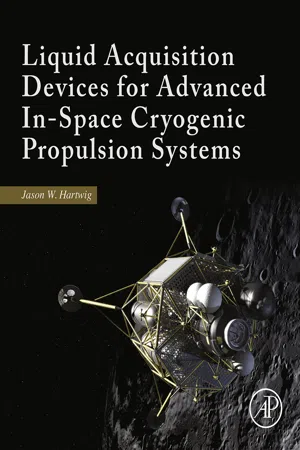
Liquid Acquisition Devices for Advanced In-Space Cryogenic Propulsion Systems
- 488 pages
- English
- ePUB (mobile friendly)
- Available on iOS & Android
Liquid Acquisition Devices for Advanced In-Space Cryogenic Propulsion Systems
About this book
Liquid Acquisition Devices for Advanced In-Space Cryogenic Propulsion Systems discusses the importance of reliable cryogenic systems, a pivotal part of everything from engine propulsion to fuel deposits. As some of the most efficient systems involve advanced cryogenic fluid management systems that present challenging issues, the book tackles issues such as the difficulty in obtaining data, the lack of quality data and models, and the complexity in trying to model these systems.The book presents models and experimental data based on rare and hard-to-obtain cryogenic data. Through clear descriptions of practical data and models, readers will explore the development of robust and flexible liquid acquisition devices (LAD) through component-level and full-scale ground experiments, as well as analytical tools.This book presents new and rare experimental data, as well as analytical models, in a fundamental area to the aerospace and space-flight communities. With this data, the reader can consider new and improved ways to design, analyze, and build expensive flight systems.- Presents a definitive reference for design ideas, analysis tools, and performance data on cryogenic liquid acquisition devices- Provides historical perspectives to present fundamental design models and performance data, which are applied to two practical examples throughout the book- Describes a series of models to optimize liquid acquisition device performance, which are confirmed through a variety of parametric component level tests- Includes video clips of experiments on a companion website
Frequently asked questions
- Essential is ideal for learners and professionals who enjoy exploring a wide range of subjects. Access the Essential Library with 800,000+ trusted titles and best-sellers across business, personal growth, and the humanities. Includes unlimited reading time and Standard Read Aloud voice.
- Complete: Perfect for advanced learners and researchers needing full, unrestricted access. Unlock 1.4M+ books across hundreds of subjects, including academic and specialized titles. The Complete Plan also includes advanced features like Premium Read Aloud and Research Assistant.
Please note we cannot support devices running on iOS 13 and Android 7 or earlier. Learn more about using the app.
Information
Introduction
Abstract
1.1 The Flexible Path



1.2 Fundamental Cryogenic Fluids
Table of contents
- Cover image
- Title page
- Table of Contents
- Copyright
- Dedication
- Foreword
- Preface
- Acknowledgments
- 1: Introduction
- 2: Background and Historical Review
- 3: Influential Factors and Physics-Based Modeling of Liquid Acquisition Devices
- 4: Room Temperature Liquid Acquisition Device Performance Experiments
- 5: Parametric Analysis of the Liquid Hydrogen and Nitrogen Bubble Point Pressure
- 6: High-Pressure Liquid Oxygen Bubble Point Experiments
- 7: High-Pressure Liquid Methane Bubble Point Experiments
- 8: Warm Pressurant Gas Effects on the Static Bubble Point Pressure for Cryogenic Liquid Acquisition Devices
- 9: Full-Scale Liquid Acquisition Device Outflow Tests in Liquid Hydrogen
- 10: The Bubble Point Pressure Model for Cryogenic Propellants
- 11: The Reseal Point Pressure Model for Cryogenic Propellants
- 12: Analytical Model for Steady Flow through a Porous Liquid Acquisition Device Channel
- 13: Optimal Liquid Acquisition Device Screen Weave for a Liquid Hydrogen Fuel Depot
- 14: Optimal Propellant Management Device for a Small-Scale Liquid Hydrogen Propellant Tank
- 15: Conclusions
- Appendix A: Historical Depot Demonstration Missions
- Appendix B: Summary of Previously Reported Bubble Point Data
- Appendix C: Langmuir Isotherm for the Liquid/Vapor Case
- Appendix D: Langmuir Isotherms for the Solid/Liquid and Solid/Vapor Cases
- Appendix E: Historical Heated Pressurant Gas Liquid Acquisition Device Tests
- Appendix F: Previously Reported Porous Channel Solutions
- Appendix G: Design Logic
- Glossary
- Bibliography
- Index